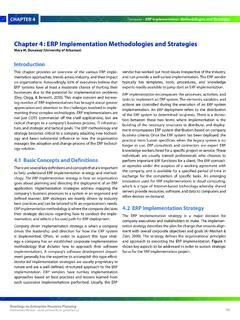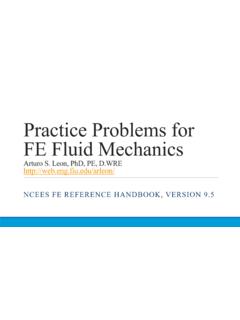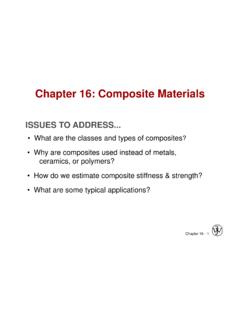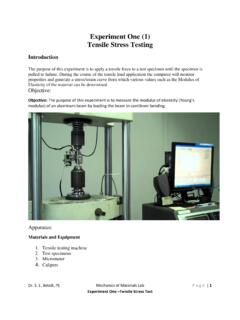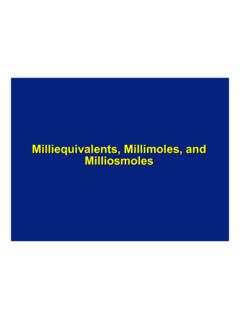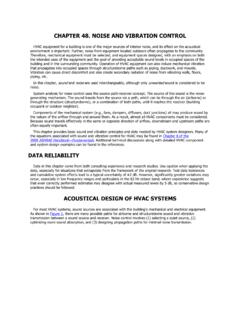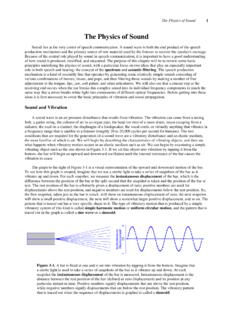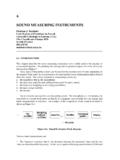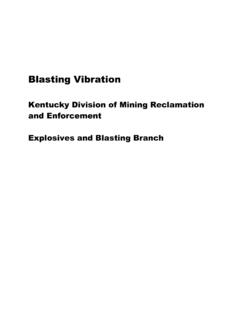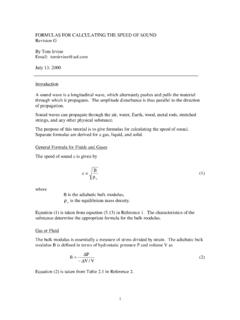Transcription of Mechanical Vibrations FUNDAMENTALS OF VIBRATION
1 Prof. Carmen Muller-Karger, PhDFigures and content adapted from Textbook: Singiresu S. Rao. Mechanical VIBRATION , Pearson sixth editionMechanical VibrationsMechanical VibrationsFUNDAMENTALS OF VIBRATIONProf. Carmen Muller-Karger, PhDFlorida International University Figures and content adapted from Textbook: Singiresu S. Rao. Mechanical VIBRATION , Pearson sixth 1: FUNDAMENTALS of VIBRATION Prof. Carmen Muller-Karger, PhDFigures and content adapted from Textbook: Singiresu S. Rao. Mechanical VIBRATION , Pearson sixth editionMechanical VibrationsLearning Objectives Recognize the importance of studying VIBRATION Describe a brief the history of VIBRATION Understand the definition of VIBRATION State the process of modeling systems Determine the Degrees of Freedom (DOF) of a system Identify the different types of Mechanical Vibrations Compute equivalent values for Spring elements, Mass elements and Damping elements Characterize harmonic motion and the different possible representation Add and subtract harmonic motions Conduct Fourier series expansion of given periodic functionsProf.
2 Carmen Muller-Karger, PhDFigures and content adapted from Textbook: Singiresu S. Rao. Mechanical VIBRATION , Pearson sixth editionMechanical VibrationsImportance of studying VIBRATION All systems that have mass and any type of flexible components are vibrating system. Examples are many: We hear because our eardrums vibrate Human speech requires the oscillatory motion of larynges In machines, VIBRATION can loosen fasteners such as nuts. In balance in machine can cause problem to the machine itself or surrounding machines or environment. Periodic forces bring dynamic responses that can cause fatigue in materials The phenomenon known as Resonance leads to excessive deflections and failure. The VIBRATION and noise generated by engines causes annoyance to people and, sometimes, damage to Carmen Muller-Karger, PhDFigures and content adapted from Textbook: Singiresu S.
3 Rao. Mechanical VIBRATION , Pearson sixth editionMechanical VibrationsImportance of studying VibrationProf. Carmen Muller-Karger, PhDFigures and content adapted from Textbook: Singiresu S. Rao. Mechanical VIBRATION , Pearson sixth editionMechanical VibrationsBrief history People became interested in VIBRATION when they created the first musical instruments ( as long as 4000 ). Pythagoras( 582 507 ) is considered the fisrtperson to investigate musical sounds. Galileo Galilei (1564-1642) is considered to be the founder of modern experimental science, he conduct experiments on the simple pendulum, describing the dependence of the frequency of VIBRATION and the length. Robert Hooke (1635 1703) also conductedexperiments to find a relation between the pitch and frequency of VIBRATION of a string.
4 Joseph Sauveur(1653 1716) coined the word acoustics for the science of sound . Sir Isaac Newton (1642 1727) his law of motion is routinely used to derive the equations of motion of a vibrating body. Brook Taylor (1685 1731), obtained the natural frequency of VIBRATION observed by Galilei and Mersenne. Daniel Bernoulli (1700 1782), Jean D Alembert(1717 1783), and Leonard Euler (1707 1783)., introduced partial derivatives in the equations of motion. J. Fourier (1768 1830)contributedon the development of the theory of Vibrations and led to the possibility of expressing any arbitrary function using the principle of superposition. Joseph Lagrange (1736 1813)presented the analytical solution of the vibrating string. Charles Coulomb did both theoretical and experimental studies in 1784 on the torsional oscillations of a metal cylinder suspended by a wire.
5 He also contributed in the modeling of dry friction. E. F. F. Chladni(1756 1824) developed the method of placing sand on a vibrating plate to find its mode shapes. Simeon Poisson (1781 1840) study VIBRATION of a rectangular flexible membrane. Lord Baron Rayleigh(1842 1919) Among the many contributions, he develop the method of finding the fundamental frequency of VIBRATION of a conservative system by making use of the principle of conservation of Carmen Muller-Karger, PhDFigures and content adapted from Textbook: Singiresu S. Rao. Mechanical VIBRATION , Pearson sixth editionMechanical VibrationsDefinition of VIBRATION Any motion that repeats itself after an interval of time. A vibratory system, in general, includes a means for storing potential energy (spring or elasticity), a means for storing kinetic energy (mass or inertia), and a means by which energy is gradually lost (damper).
6 Excitations(input): Initial conditions of external forceResponses (output) T UDEnergy dissipationF(t)r(t)Prof. Carmen Muller-Karger, PhDFigures and content adapted from Textbook: Singiresu S. Rao. Mechanical VIBRATION , Pearson sixth editionMechanical VibrationsModeling systems All Mechanical and structural systems can be modeled as mass-spring-damper systemsReal systemMechanical ModelMathematical Model SolutionAnalysis + + =0 Respuestaan lisisdelsistemaparaquelarespuestaseacohe rente. + + =0 Respuestaan Carmen Muller-Karger, PhDFigures and content adapted from Textbook: Singiresu S. Rao. Mechanical VIBRATION , Pearson sixth editionMechanical VibrationsDegrees of freedomSingle DoFsystems: Two DOF System The minimum number of independent coordinates required to determine completely the positions of all parts of a system at any instant of timeThree DoFsystems: Prof.
7 Carmen Muller-Karger, PhDFigures and content adapted from Textbook: Singiresu S. Rao. Mechanical VIBRATION , Pearson sixth editionMechanical VibrationsClassification of VIBRATION Free VIBRATION : When a system, after an initial disturbance, is left to vibrate on its own. No external force acts on the system. The system oscillates at its natural frequency. Example: a pendulum. Forced VIBRATION : When a system is subjected to an external force (often, a repeating type of force). The oscillation that arises in machines such as diesel engines is an example of forced Carmen Muller-Karger, PhDFigures and content adapted from Textbook: Singiresu S. Rao. Mechanical VIBRATION , Pearson sixth editionMechanical VibrationsTypes of response Undamped and damped VIBRATION Linear of nonlinear VIBRATION Deterministic ondRandom VIBRATION + =0 Prof.
8 Carmen Muller-Karger, PhDFigures and content adapted from Textbook: Singiresu S. Rao. Mechanical VIBRATION , Pearson sixth editionMechanical VibrationsMechanical VibrationsSPRING, MASS and DAMPING ELEMENTSProf. Carmen Muller-Karger, PhDFlorida International University Figures and content adapted from Textbook: Singiresu S. Rao. Mechanical VIBRATION , Pearson sixth 1: FUNDAMENTALS of VIBRATION Prof. Carmen Muller-Karger, PhDFigures and content adapted from Textbook: Singiresu S. Rao. Mechanical VIBRATION , Pearson sixth editionMechanical VibrationsSpring ElementsThe force related to a elongation or reduction in length opposes to the displacement of the end of the spring and is given by : = The work done (U) in deforming a spring is stored as strain or potential energy in the spring, and it is given by =12 2 = + 3 Non-linear spring element: = Prof.
9 Carmen Muller-Karger, PhDFigures and content adapted from Textbook: Singiresu S. Rao. Mechanical VIBRATION , Pearson sixth editionMechanical VibrationsExample: Spring constant of a rod Find the equivalent spring constant of a uniform rod of lengthl, cross-sectional areaA, Area Moment of Inertia I and Young s modulusE = = = = = =3 3 = 33 = = = 1. Subjected to an axial tensile (or compressive) forceF2. Cantilever bean subjected to a transversal load at the free end. Prof. Carmen Muller-Karger, PhDFigures and content adapted from Textbook: Singiresu S. Rao. Mechanical VIBRATION , Pearson sixth editionMechanical VibrationsOriginal systemEquivalent modelSpring Constant of a Rod under axial loadCantilever beam with end forceSimple support beam with load in the middle Propeller Shaft subjected to a torsional momentEquivalent spring constants = =3 3 = = ( 4 4)32 =48 3 Prof.
10 Carmen Muller-Karger, PhDFigures and content adapted from Textbook: Singiresu S. Rao. Mechanical VIBRATION , Pearson sixth editionMechanical VibrationsCombination of Springs Springs in ParallelSprings in SeriesW= 1 + 2 W=( 1+ 2) W=( ) =( 1+ 2)W= 1 1= 2( 1)= 1= 11 =1 1+1 2 1= 2( 2 1) = 2 1= = 2+ 1 Prof. Carmen Muller-Karger, PhDFigures and content adapted from Textbook: Singiresu S. Rao. Mechanical VIBRATION , Pearson sixth editionMechanical VibrationsMass or Inertia Elements The mass or inertia element is assumed to be a rigid body; it can gain or lose kinetic energy whenever the velocity of the body changes. For single DoFsystem for a simple analysis, we can replace several masses by a single equivalent mass. The key step is to choose properly a parameter that will describe the motion of the system and express all other parameters in term of the chosen one.

